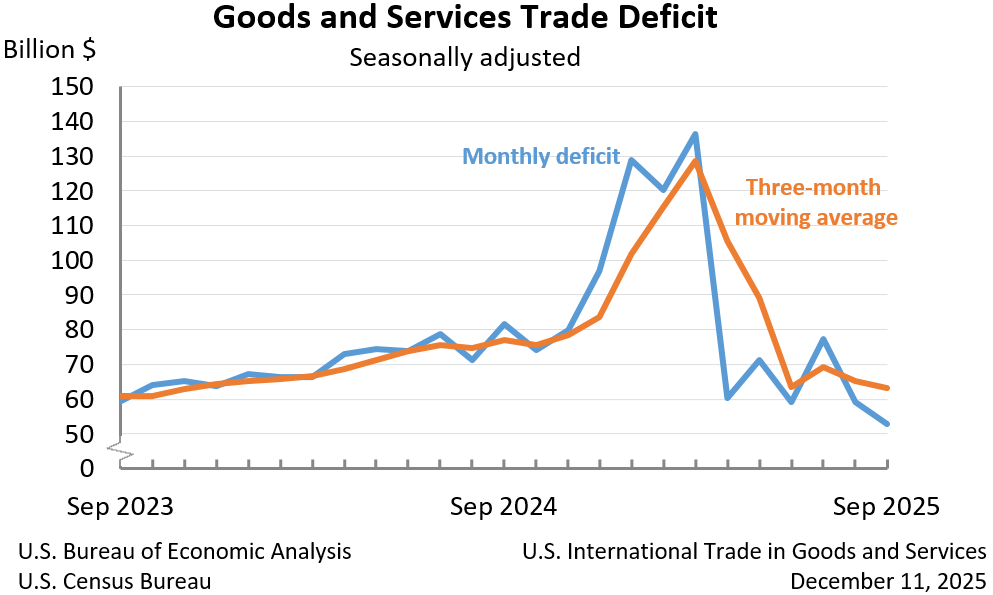Bureau of Economic Analysis
U.S. International Trade in Goods and Services, September 2025
The U.S. goods and services trade deficit decreased in September 2025 according to the U.S. Bureau of Economic Analysis and the U.S. Census Bureau. The deficit decreased from $59.3 billion in August (revised) to $52.8 billion in September, as exports increased more than imports. The goods deficit decreased $7.1 billion in September to $79.0 billion. The services surplus decreased $0.6 billion in September to $26.2 billion.
Principal Federal Economic Indicators
Noteworthy
The Latest
November 2019 Trade Gap is $43.1 Billion
The U.S. monthly international trade deficit decreased in November 2019 according to the U.S. Bureau of Economic Analysis and the U.S. Census Bureau. The deficit decreased from $46.9 billion in October (revised) to $43.1 billion in November, as exports increased and imports decreased. The previously published October deficit was $47.2 billion. The goods deficit decreased $3.9 billion in November to $63.9 billion. The services surplus…
U.S. International Trade in Goods and Services, November 2019
The U.S. monthly international trade deficit decreased in November 2019 according to the U.S. Bureau of Economic Analysis and the U.S. Census Bureau. The deficit decreased from $46.9 billion in October (revised) to $43.1 billion in November, as exports increased and imports decreased. The previously published October deficit was $47.2 billion. The goods deficit decreased $3.9 billion in November to $63.9 billion. The services surplus decreased…
U.S. International Investment Position Third Quarter 2019
The U.S. net international investment position, the difference between U.S. residents’ foreign financial assets and liabilities, was –$10.95 trillion at the end of the third quarter of 2019, according to statistics released by the U.S. Bureau of Economic Analysis (BEA). Assets totaled $28.26 trillion and liabilities were $39.21 trillion. At the end of the second quarter, the net investment position was –$10.61 trillion.
U.S. International Investment Position, Third Quarter 2019
The U.S. net international investment position, the difference between U.S. residents’ foreign financial assets and liabilities, was –$10.95 trillion at the end of the third quarter of 2019, according to statistics released by the U.S. Bureau of Economic Analysis (BEA). Assets totaled $28.26 trillion and liabilities were $39.21 trillion. At the end of the second quarter, the net investment position was –$10.61 trillion.
Personal Income and Outlays, November 2019
Personal income increased 0.5 percent in November after increasing 0.1 percent in October. Wages and salaries, the largest component of personal income, increased 0.4 percent in November after increasing 0.5 percent in October.
Personal Income and Outlays, November 2019
Personal income increased 0.5 percent in November after increasing 0.1 percent in October. Wages and salaries, the largest component of personal income, increased 0.4 percent in November after increasing 0.5 percent in October.
GDP Increases in Third Quarter
Real gross domestic product (GDP) increased 2.1 percent in the third quarter of 2019, according to the “third” estimate released by the Bureau of Economic Analysis. The growth rate was unrevised from the “second” estimate released in November. In the second quarter, real GDP rose 2.0 percent.
Gross Domestic Product, Third quarter 2019 (third estimate); Corporate Profits, Third quarter 2019 (revised estimate)
Real gross domestic product (GDP) increased 2.1 percent in the third quarter of 2019, according to the “third” estimate released by the Bureau of Economic Analysis. The growth rate was unrevised from the “second” estimate released in November. In the second quarter, real GDP rose 2.0 percent.
U.S. Current Account Deficit Narrows in Third Quarter 2019
The U.S. current account deficit, which reflects the combined balances on trade in goods and services and income flows between U.S. residents and residents of other countries, narrowed by $1.1 billion, or 0.9 percent, to $124.1 billion in the third quarter of 2019. The narrowing mainly reflected a reduced deficit on goods and an expanded surplus on primary income. The third quarter deficit was 2.3 percent of current dollar gross domestic…
U.S. International Transactions, Third Quarter 2019
The U.S. current account deficit narrowed by $1.1 billion, or 0.9 percent, to $124.1 billion in the third quarter of 2019, according to statistics from the U.S. Bureau of Economic Analysis. The revised second quarter deficit was $125.2 billion. The third quarter deficit was 2.3 percent of current dollar gross domestic product, down less than 0.1 percent from the second quarter.




